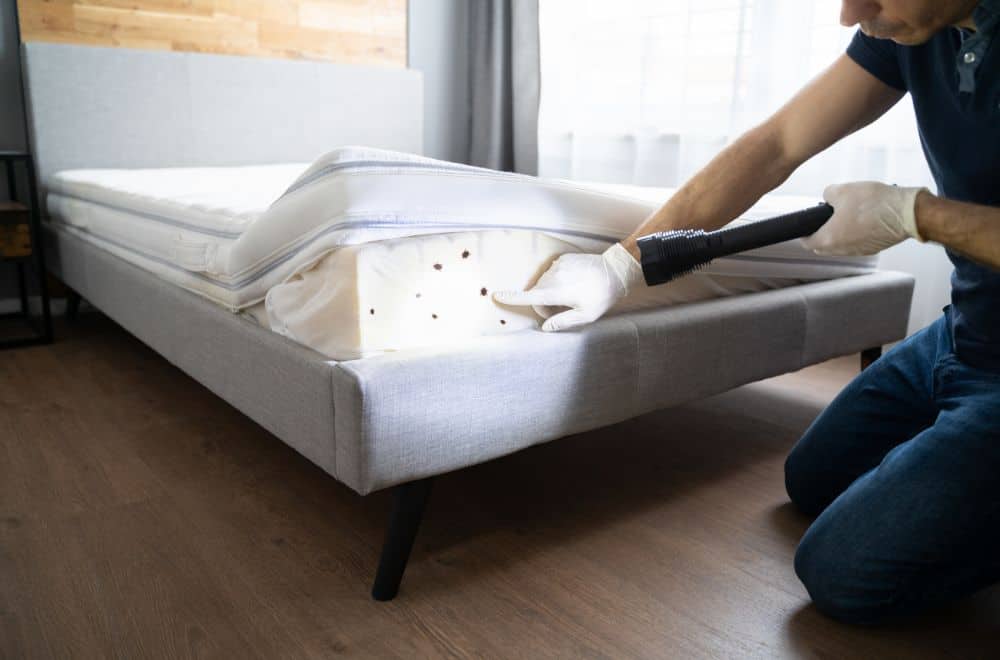Let’s face it, the idea of sharing our beds with creepy crawlies isn’t something most of us relish! But the reality is that many tiny critters like to make their homes in dark, warm places. And that can include our beds!
The most well-known of these are bed bugs – but they’re not the only potential culprits. And lots of other bugs sometimes find themselves confused for their better known cousins.
So just how do you tell the difference? That’s where we come in! Read on to discover some key facts about 10 tiny bugs in bed that are not bed bugs…
Tiny Bugs in Bed That Are Not Bed Bugs
1. Bat bugs
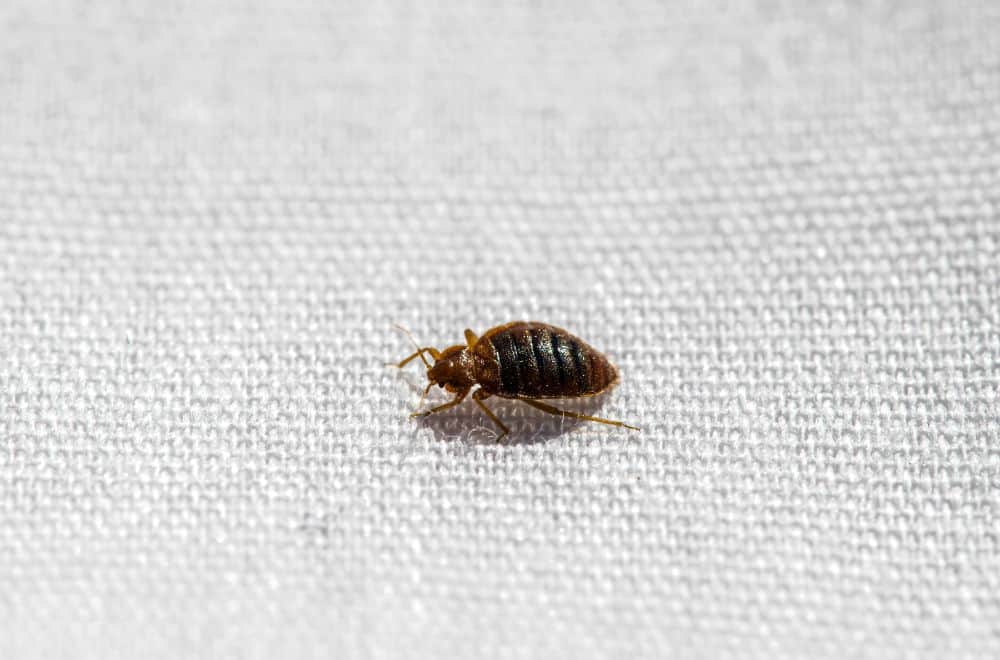
Let’s start with the trickiest customer to distinguish from the bed bug. To the casual observer, the bed bug and the bat bug are virtually identical. But look more closely, and you’ll be able to spot some differences.
The first is the color. The bat bug – or Cimex pilosellus, to give it its Latin name – tends to be beige or brown. The bed bug, however, usually has a ruddier color, similar to mahogany.
The other main clue is size. Bed bugs are generally bigger, measuring about a quarter of an inch or so across. Bat bugs range from 2 millimeters to 5 millimeters. The top end of that scale is admittedly not far off the usual size of a bed bug. But if you’ve got a little one, the chances are it’s a bat bug.
Fortunately, there are other factors aside from their appearance that can help you tell the two species apart.
Bat bugs, as their name suggests, feed on the blood of bats. That means they’re likely to be in places where bats roost, like attics or barns. They’ll only migrate close to people if the bats have left the building.
They’re picky about their geographical environment too. While bed bugs are a worldwide menace, bat bugs are confined to the Midwestern USA.
So if you don’t have an attic or you’re on the ground floor of a multistorey building, the chances of meeting bat bugs are slim. And if you’re outside the Midwest, they won’t bother you at all.
2. Dust mites

If you have dust mites in your bed, the chances are you won’t even know about it. These tiny little creatures are barely visible with the naked eye. And unlike bed bugs, they don’t chow down on live flesh – so you won’t have bite marks to give away their presence.
They do, however, feed on dead skin – nice! And pet dander, pollen and bacteria are other tasty dust mite treats.
They like warm and humid places too, all of which makes your mattress a thoroughly desirable residence. They’ll also set up home in carpets, and on curtains and upholstered furniture.
While the thought of them isn’t pleasant, they won’t usually cause you any problems. But if enough mites – and their droppings – accumulate in your mattress, they can cause allergies.
Washing your bedding regularly at a hot temperature will help. And vacuuming your mattress will get rid of mites, as long as you use a cleaner with the right filter. You’ll need one with either a HEPA (high efficiency particulate air) filter, or a double layered microfilter bag.
3. Fleas

Fleas are well known for nipping at people. But if you’re waking up covered in bites, it’s actually quite unlikely that they’re living in your mattress.
Fleas are not typical mattress-dwellers. They love warm, moist places, but they need a ready supply of blood. If they’ve found their way into your bed, it’s probably because they’ve hitched a lift with a pet.
Yes, we know Fido/Tiddles loves to cuddle up to you, and yes, it’s pretty darned cute! But if you’re getting flea bites at night, they’re probably to blame.
Ask your veterinary surgeon for advice on the right treatment to rid your furry friends of fleas. And when you’ve washed your bedding and thoroughly vacuumed your mattress, you shouldn’t need to worry about them again.
4. Mosquitoes
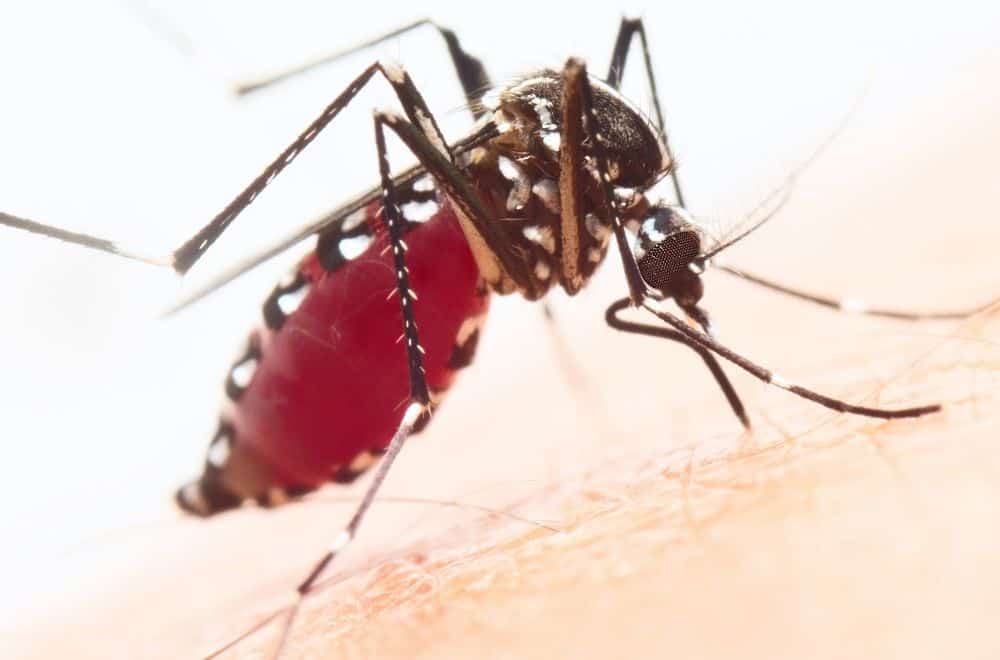
Mosquitoes are notorious biters, and they’re very active at night. So if you’ve woken to find your skin patterned with lumpy red bites, they could be the culprits.
The good news, though, is that they don’t live in bedding. Instead, they fly around making a high-pitched whining noise like an air raid siren warning of an incoming attack! Too bad you’re sound asleep and can’t hear it…
One way you can identify which bug is to blame for bites is by looking at the marks they leave behind.
While mosquitoes bites are usually dotted all over the place, bed bug bites often appear in clusters. And they sometimes form lines that match where the edge of your mattress sits against your skin.
Mozzy bites are usually itchy straight away too. With bed bug bites, on the other hand, it can take up to two weeks for the itch to make its annoying presence felt.
Send mosquitoes packing with a bug spray or citronella diffuser. Placing a mosquito net over your bed is another good way to keep them at bay.
5. Ticks

Unlike mosquitoes, ticks love the warm, dark environment of your bed. Mattresses, sheets, pillows, duvets and blankets – they’re all the definition of tick heaven.
Ticks tend to feed on animals, but some kinds will snack on humans too. Once they’ve attached themselves to their host, they can stay there for several days without you being any the wiser. They can carry diseases like Lyme disease too, so none of this is good news.
You can tell them apart from bed bugs by counting their legs. Bed bugs have six, while ticks have eight. Bed bugs are usually bigger too – most types of tick are only a few millimeters long.
If you’ve found ticks, get your bedding into a hot wash as soon as possible. Vacuum your mattress thoroughly, as well as the rest of your bedroom.
Pesticides may be needed to get rid of any bugs that remain. Products including pyrethrin will eradicate brown dog ticks.
6. Body lice
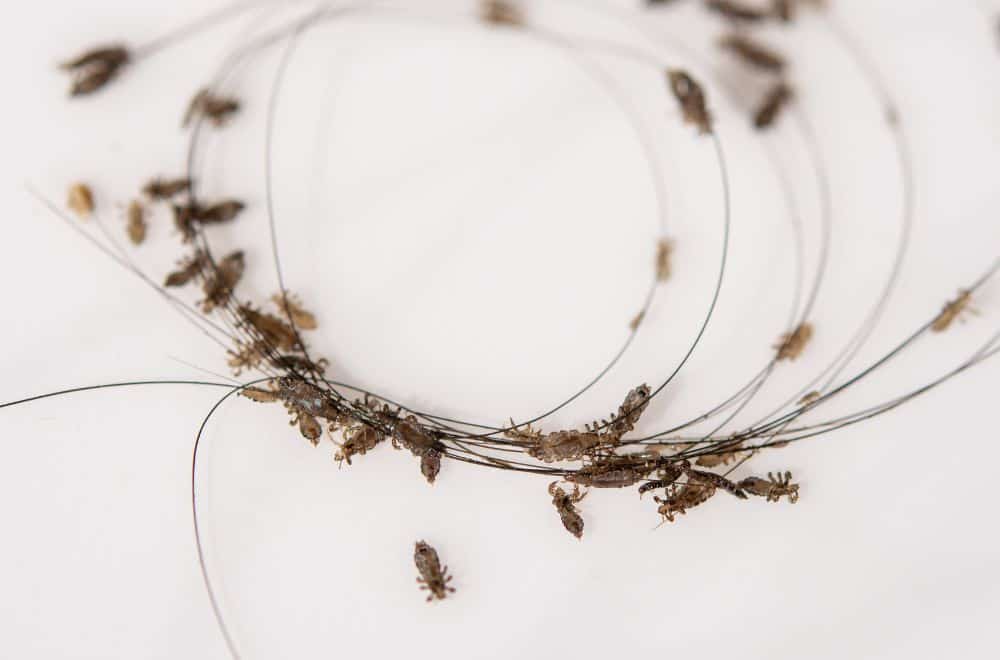
The very words “body lice” are enough to make us shudder! Because sure enough, these bugs make their home in clothes and bedding. From there, they take several outings a day to dine on your blood. Ew!
They’re most commonly found in places where people are living in unhygienic and overcrowded conditions. You can catch them from contact with the clothing of an infected person. And the bites of body lice can spread diseases including trench fever and typhus.
The insects themselves are tiny, about the size of sesame seeds. They most commonly leave bites around people’s necks, shoulders, waists, groins and armpits. And if you have body lice for a long time, your skin may become thicker and discolored.
If you suspect body lice, launder clothes and bedding in hot water. Then dry them in an automatic drier on a high heat setting. Good personal hygiene and changing clothes at least once a week will minimize the risk of encountering these pests.
7. Spider beetles
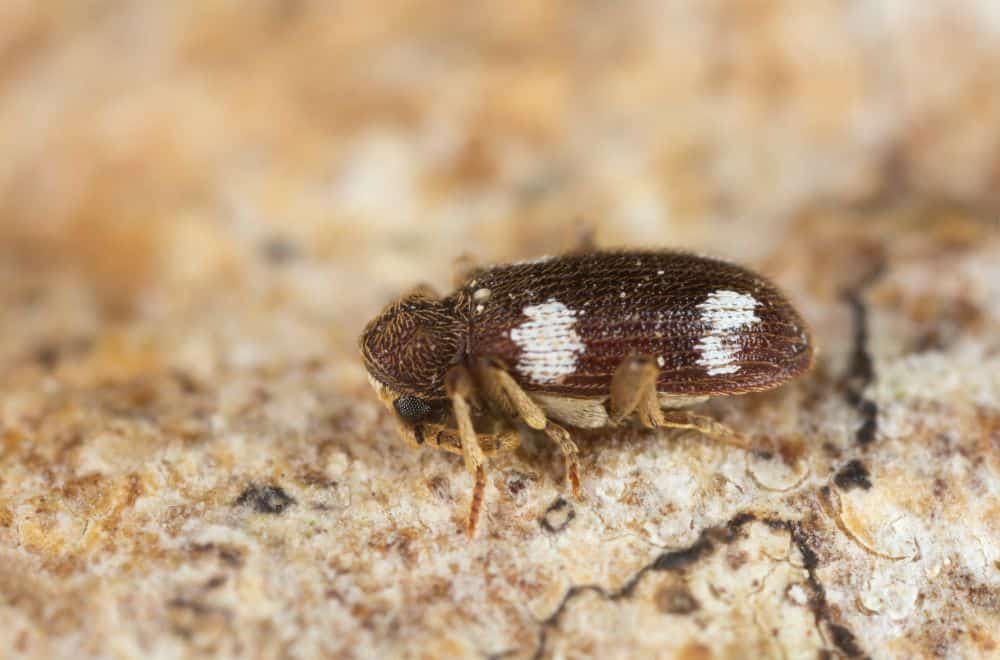
Spider beetles can be mistaken for bed bugs because they look quite similar. But the good news is that these little critters are highly unlikely to turn up between your sheets!
Instead, they’re usually found in locations like grain stores, where there’s a plentiful supply of food. And if they turn up in your bedroom, they’ve probably taken a wrong turning at the pantry.
Their resemblance to bed bugs lies in their brown, oval bodies. But they’re smaller than their vampiric cousins, with adults typically ranging from between 1.5 to 3.5 millimeters long. They also have a distinctive hunchback, quite unlike the flat bed bug profile.
While spider beetles won’t cause you any harm, an infestation in your home can still be problematic. They’ll be there because there’s a supply of food, so clean out cupboards and vacuum floors. Make sure there’s no damaged packaging that’s providing the beetles with an all-you-can-eat buffet.
If there’s nothing for them to eat, they’ll soon find other, more hospitable environments.
8. Booklice
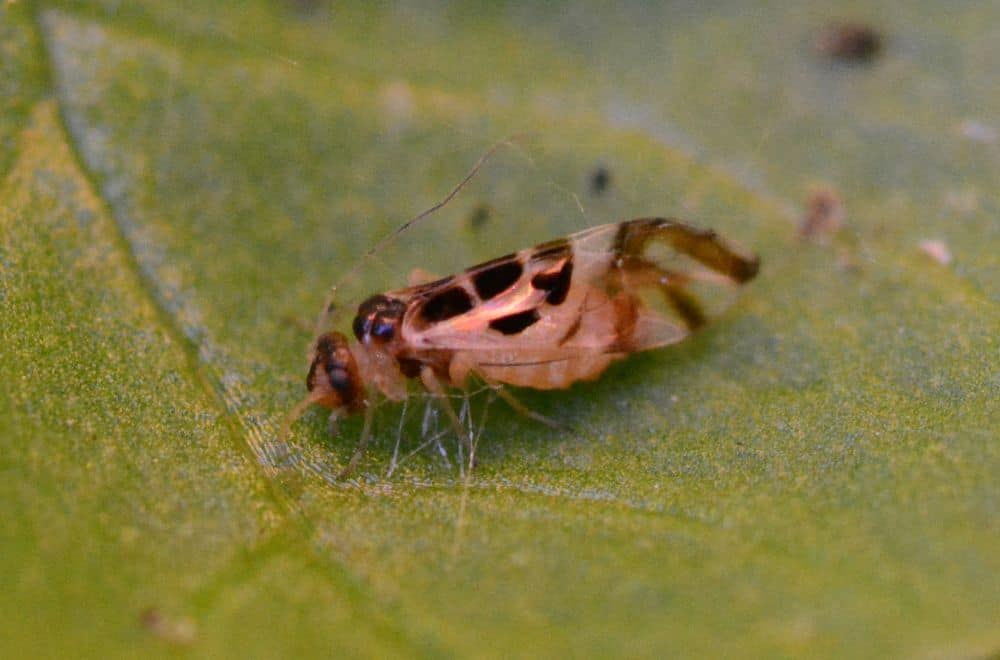
Booklice are a pretty common household pest. They can crop up anywhere, even in the cleanest homes. Happily, though, they’re pretty harmless.
They get their name from one of their common habitats – the spines of old books. They’re not great readers, though! They’re there because they enjoy eating the paste used to attach the pages to the spine. And they’re just as happy anywhere else it’s warm and damp.
They’re a type of insect called a psocid, which means they feed on mold or fungi. And some kinds of booklice can eat into human food stores too.
All booklice are female, and they reproduce by laying eggs. They’re very small – just a millimeter or two long – and they have flat bodies that are either cream or beige. They’ve got large mouths and long antennae. And if they’re the kind that live indoors, they won’t have wings.
Getting rid of them is easy as long as you can get rid of the damp they thrive in. Fix any leaks and keep rooms well heated in cold and damp weather. A dehumidifier can also be a good shout to speed things up.
9. Cockroach nymphs
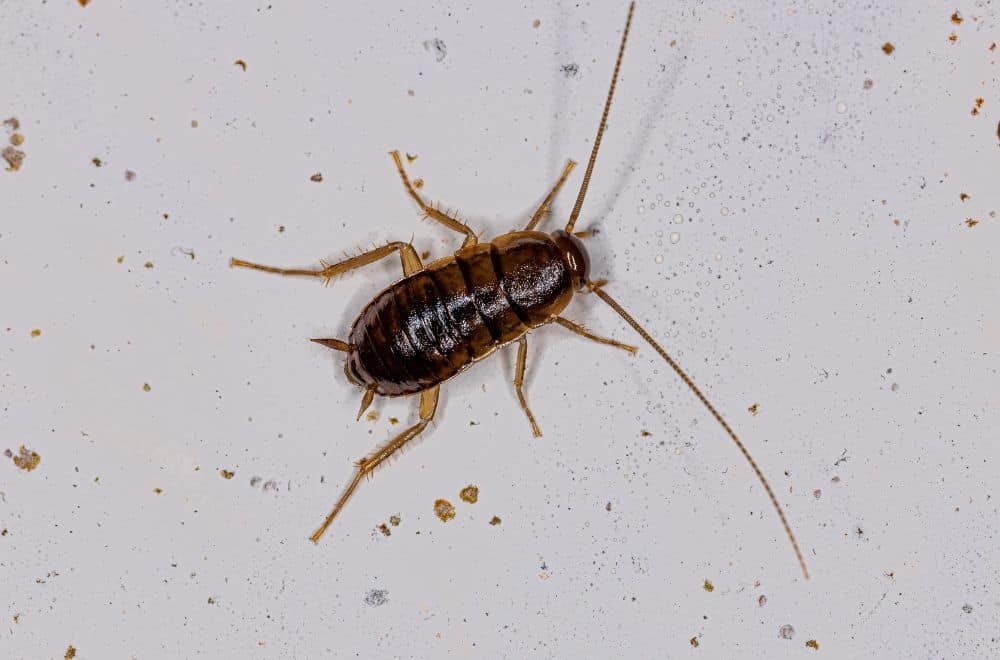
Cockroaches are famously resilient, reputedly one of the few living creatures tough enough to survive a nuclear explosion. Nymphs are young cockroaches, just emerged from their eggs. And they are another insect that love warm, damp environments.
You’re most likely to find them in bathrooms or kitchens, locations where they can readily find food. But if you’re unlucky, they may find their way into your bedroom too.
So how do you identify them? Unlike bed bugs, their bodies are cylindrical rather than flat. They have much longer antennae too, almost as long as their bodies. The antennae of bed bugs, on the other hand, are no more than half the length of their bodies.
They’re usually bigger than bed bugs. Nymphs are generally between a quarter and half an inch long, growing to between one and two inches as mature cockroaches. They start off life white, but turn reddish brown as they get older.
While they might not be welcome guests, they’re very unlikely to bite you.
And you can put them off invading your bedroom by practising good food hygiene. If there’s no food debris for them to eat, there’s no reason for them to set up home. So get out the vacuum cleaner if you’ve been munching on late night cookies!
10. Carpet beetles
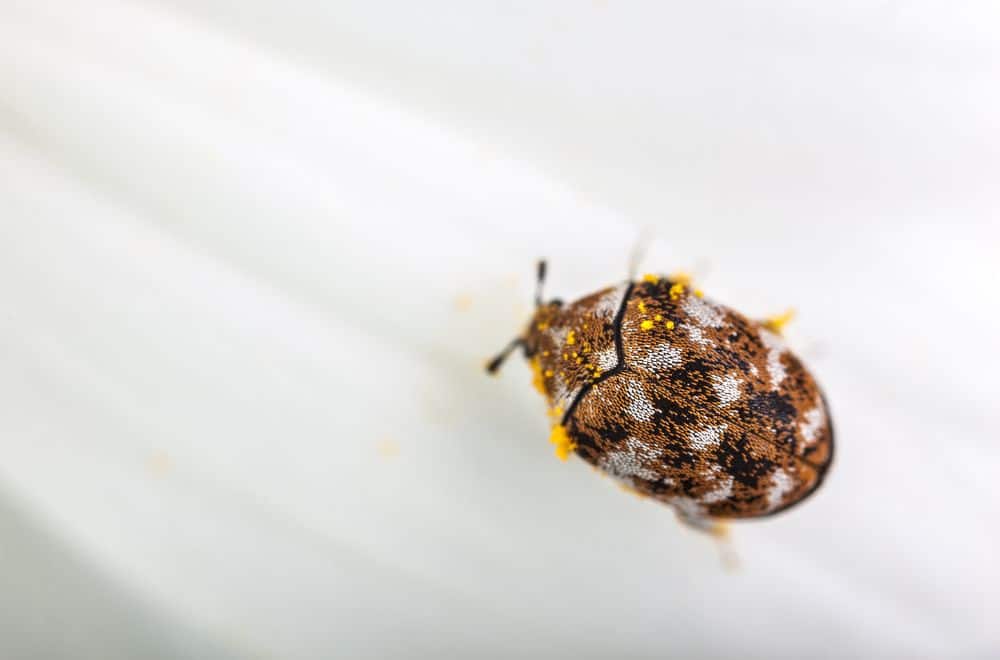
Carpet beetles enjoy nothing more than a tasty meal of natural fibers. Wool, cotton, silk or leather, they love them all! And that makes your bedding a tempting menu for these little critters.
They can also infest upholstered furniture, curtains and – you’ve guessed it – carpets. So getting an infestation can be an expensive business. And it’s important to take action at the first sign of their presence in your home.
They have oval bodies similar in shape to bed bugs – but they’re much more colorful. Their exoskeletons are covered in black, white and orange or yellow stripes.
They’re a little smaller than bed bugs, with fully grown adults measuring about 4 millimeters long. Interestingly, they get smaller as they grow: carpet beetle larvae are about an inch long.
They can fly, so it’s easy for them to get in through an open window. And if they’re left unmolested – and with plenty to eat – they can reproduce quickly.
Signs of an infestation include holes in bedding or other fabrics. And the adult insects are attracted to the light. Switching on a lamp in a darkened room is a good way to draw them out of hiding.
The easiest way to avoid a carpet beetle problem is with good food hygiene and regular cleaning and vacuuming. Be particularly thorough next to skirting boards, as this is often where they lay their eggs. Get out your vacuum cleaner nozzle attachment and run it along the edges.
Steam cleaning is good for removing eggs and larvae from hard surfaces. And spraying or wiping vinegar mixed with water onto hard surfaces acts as a natural deterrent.
Bugs in beds aren’t always bed bugs!
As we’ve seen, having a bug in your bed doesn’t mean you have bed bugs! There are lots of other insects that can make their home in your bedding. And there are others that can be easily mistaken for bed bugs, despite having quite different habitats.
Many of these insects are harmless, but some can cause damage or even carry disease. Keeping your bedroom clean and tidy, washing your bedding regularly, and frequent vacuuming will all help keep your bed a bug-free zone.
